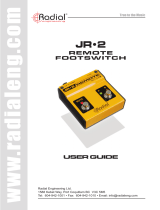
True to the Music
Radial Engineering Ltd.
PHASE
0º 180º
INVERT
ON
180º~360º
POWER
FILTER
38kHz3kHz
3.8kHz
300Hz
SHIFT
SHIFT BLEND
DRY WET
6
ADJUSTING THE PHASE
The phase section is tuned by ear using two controls. To best hear the ef-
fect of each control set your mixer controls for both signals (one with the
Phazer inserted and one without) to equal volume and panned center in
your monitors, follow these steps.
For the most part the goal is to shift the close mic signal until the funda-
mentals phase-align with the distant mic in a musical and pleasing way
that compliments the instrument and program material. Keep in mind it
is impossible for all frequencies to line up or be in perfect phase at the
same time. When tuning the SHIFT control, simply use your ears to nd
what sounds best to you.
The Invert Function
The INVERT control is used to reverse the absolute phase of the signal
passing through the Phazer and allow the SHIFT control to access the
181° to 360° phase range.
The INVERT switch can also be used for several clever functions. For
instance, not all microphones and direct boxes produce the same polarity
at their output. The INVERT switch can be used to correct the polarity of
one device to match another.
When listening for the 'sweet spot' it can sometimes be easier to hear
phase cancellation rather than reinforcement. Employ the INVERT
switch to help you tune the SHIFT control while listening for maximum
phase cancellation. When you've found the spot that produces the
weakest sound hit the INVERT button again and the effect switches from
maximum cancellation to maximum reinforcement. This is most effective
when tuning the effect to the fundamental frequency.
Using the Phazer as a creative EQ
Filtering a signal through phase cancellation is one way to make tracks
sit better in the mix without ghting with other instruments in the same
register. Try phase shifting the rhythm guitar part while monitoring the
other rhythm section instruments to see how you can change the bal-
ance without adjusting fader levels. The blend function lets you apply
this technique using a single sound and phase 'canceling' to create an
effect. It's fun!
Phazer
™
Start with the INVERT switch
A
in the out-
ward position and the SHIFT control turned
full counter-clockwise. Make Sure the BLEND
control
D
is also fully clockwise (WET).
Engage the PHASE ON switch
B
, the LED will
illuminate.
Slowly rotate the SHIFT control
C
clockwise
while listening. Tune the control by ear to best
suit the program material.
B A
DC






















